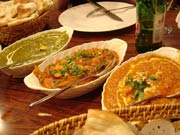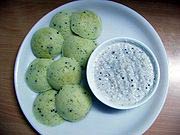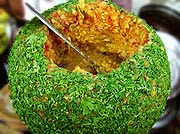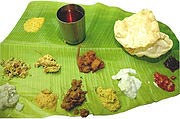Cuisine of India (Contd...)
Geographical varieties
Northern

Main article: North Indian cuisine
Typical north Indian dishes.North Indian cuisine is distinguished by the proportionally high use of dairy products; milk, paneer, ghee (clarified butter), and yoghurt (yogurt, yoghourt) are all common ingredients. Gravies are typically dairy-based. Other common ingredients include chilies, saffron, and nuts.
North Indian cooking features the use of the "tawa" (griddle) for baking flat breads like roti and paratha, and "tandoor" (a large and cylindrical coal-fired oven) for baking breads such as naan, and kulcha; main courses like tandoori chicken also cook in the tandoor. Other breads like puri and bhatoora, which are deep fried in oil, are also common. Goat and lamb meats are favored ingredients of many northern Indian recipes.
The samosa is a popular North Indian snack, and now commonly found in other parts of India, Central Asia, North America, and the Middle East. A common variety is filled with boiled, fried, or mashed potato. Other fillings include minced meat, cheese (paneer), mushroom (khumbi), and chick pea.
The staple food of most of North India is a variety of lentils, vegetables, and roti (wheat based bread). The varieties used and the method of preparation can vary from place to place. Popular snacks, side-dishes and drinks include mirchi bada, buknu, bhujiya, chaat, kachori, imarti, several types of pickles (known as achar), murabba, sharbat, aam panna and aam papad. Popular sweets are known as mithai (meetha means sweet in Hindi), such as gulab jamun, jalebi, peda, petha, rewdi, gajak, bal mithai, singori, kulfi, falooda, khaja, ras malai, gulkand, and several varieties of laddu, barfi and halwa.
Some common North Indian foods such as the various kebabs and most of the meat dishes originated with Muslimsí incursions into the country. Considering their shared historic and cultural heritage, Pakistani cuisine and north Indian cuisine are very similar.
Eastern
 Popular Bengali sweets, such as sandesh, displayed at a shop in Kolkata.East Indian cuisine is famous for its desserts, especially sweets such as rasagolla, chumchum, sandesh, rasabali, chhena poda, chhena gaja, and kheeri. Many of the sweet dishes now popular in Northern India initially originated in the Bengal and Orissa regions. Apart from sweets, East India cuisine offers delights of posta (poppy seeds).
Popular Bengali sweets, such as sandesh, displayed at a shop in Kolkata.East Indian cuisine is famous for its desserts, especially sweets such as rasagolla, chumchum, sandesh, rasabali, chhena poda, chhena gaja, and kheeri. Many of the sweet dishes now popular in Northern India initially originated in the Bengal and Orissa regions. Apart from sweets, East India cuisine offers delights of posta (poppy seeds).
Traditional Bengali cuisine is not too spicy, not too faint. General ingredients used in Bengali curries are mustard seeds, cumin seeds, black cumin, green chillies and cumin paste. Mustard paste, curd, nuts, poppy seed paste and cashew paste are preferably cooked in mustard oil. Curries are classified into bata (paste), bhaja (fries), chochchoree (less spicy vapourized curries) and jhol (thin spicy curries).These are eaten with plain boiled rice or ghonto (spiced rice). Traditional Bengali breakfast includes pantabhat (biotically degenerated boiled rice), doi-chirey, doodh-muree with fruits. Bangladesh's cuisine is very similar to that of West Bengal, corresponding to the link between Pakistani and northern Indian cuisine. Fish is relatively commonly consumed in the eastern part of India, most especially in Bengal.
Like South India, rice is the staple grain in Eastern India too. A regular meal consists of many side dishes made of vegetables. The popular vegetable dishes of Orissa are Dalma and Santula. The most popular vegetable dish of Bengal is Sukto. Deep fried, shallow fried and mashed vegetables are also very popular. Fish frequently features in a regular meal.
Southern
 Idlis with coconut chutney, a well-known dish from southern IndiaMain article: South Indian cuisine
South Indian cuisine is distinguished by a greater emphasis on rice as the staple grain, the ubiquity of sambar and rasam (also called saaru and rasa), a variety of pickles, and the liberal use of coconut and particularly coconut oil and curry leaves. The dosa, poori, idli, vada, bonda and bajji are typical South Indian favorites. These are generally consumed as breakfast. Hyderabadi biryani, a popular type of biryani, reflects the diversity of south Indian cuisine.
Idlis with coconut chutney, a well-known dish from southern IndiaMain article: South Indian cuisine
South Indian cuisine is distinguished by a greater emphasis on rice as the staple grain, the ubiquity of sambar and rasam (also called saaru and rasa), a variety of pickles, and the liberal use of coconut and particularly coconut oil and curry leaves. The dosa, poori, idli, vada, bonda and bajji are typical South Indian favorites. These are generally consumed as breakfast. Hyderabadi biryani, a popular type of biryani, reflects the diversity of south Indian cuisine.
Andhra, Chettinad, Tamil, Hyderabadi, Mangalorean, and Kerala cuisines each have distinct tastes and methods of cooking . In fact each of the South Indian states has a different way of preparing sambar; a connoisseur of South Indian food will very easily tell the difference between sambar from Kerala, sambar from Tamil cuisine, Sambar from Karnataka and pappu chaaru in Andhra cuisine.Some popular dishes include the Biriyani, Ghee Rice with meat curry, seafood (prawns, mussels, mackerel) and paper thin Pathiris from Malabar area.
Western

Ragada in a pani puri, a popular snack from Mumbai.Western India has three major food groups: Gujarati, Maharashtrian and Goan. Maharashtrian cuisine has mainly two sections defined by the geographical sections. The coastal regions, geographically similar to Goa depend more on rice, coconut, and fish. The hilly regions of the Western Ghats and Deccan plateau regions use groundnut in place of coconut and depend more on jowar (sorghum) and bajra (millet) as staples. Saraswat cuisine forms an important part of coastal Konkani Indian cuisine. Gujarati cuisine is predominantly vegetarian. Many Gujarati dishes have a hint of sweetness due to use of sugar or brown sugar. Goan cuisine is influenced by the Portuguese colonization of Goa.
North Eastern
The food of the North East is very different from other parts of India. This area's cuisine is more influenced by its neighbours, namely Burma and the People's Republic of China. Its use of well known Indian spices is less. Yak is a popular meat in this region of India.
Beverages

While masala tea (left) is a staple beverage across India, Indian filter coffee (right) is especially popular in southern India[37][38]See also: Indian wine
Tea is a staple beverage throughout India; the finest varieties are grown in Darjeeling and Assam. It is generally prepared as masala chai, wherein the tea leaves are boiled in a mix of water, spices such as cardamom, cloves, cinnamon, and ginger, and large quantities of milk to create a thick, sweet, milky concoction. Different varieties and flavors of Tea are prepared to suit different tastes all over the country. Another popular beverage, coffee, is largely served in South India. One of the finest varieties of Coffea arabica is grown around Mysore, Karnataka, and is marketed under the trade name "Mysore Nuggets". Indian filter coffee, or kaapi, is also especially popular in South India. Other beverages include nimbu pani (lemonade), lassi, chaach, badam doodh (milk with nuts and cardamom), sharbat and coconut water. India also has many indigenous alcoholic beverages, including palm wine, fenny, bhang and Indian beer. However the practice of drinking a beverage with a meal, or wine and food matching, is not traditional or common in India.
Although the above listed beverages are popular, people prefer to consume drinking water with their food. In fact it is custom to offer drinking water to guests before serving hot or cold drinks, also drinking water does not overshadow the taste of food.
Etiquette

In southern India, a well-rinsed banana leaf is used as a plate for hygiene purposes and its visual impactMain article: Etiquette of Indian dining
Several customs are associated with the manner of food consumption. Traditionally, meals are eaten while seated either on the floor or on very low stools or cushions. Food is most often eaten without cutlery, using instead the fingers of the right hand. However, these traditional ways of dining are being influenced by eating styles from other parts of the world. Eating with your hands is considered important in Indian etiquette because a person eating with his hands knows the exact temperature of food before the morsel hits his mouth thus preventing blisters in mouth due to consumption of hot food.
Traditional serving styles vary from region to region in India. A universal aspect of presentation is the thali, a large plate with samplings of different regional dishes accompanied by raita, breads such as naan, puri, or roti, and rice. In South India, a cleaned banana leaf is often used as a hygenic and visually interesting alternative to plates.